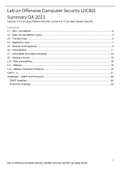Samenvatting
Lab on Offensive Computer Security (2IC80) Summary Q4 2021
- Instelling
- Technische Universiteit Eindhoven (TUE)
EN: Lab on Offensive Computer Security (2IC80) is a course taught at Eindhoven University of Technology. It is an elective course part of the package Security for CSE, which is meant for Bachelor Computer Science and Engineering students. The course is given in the fourth quartile of the second or ...
[Meer zien]




